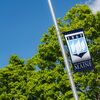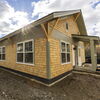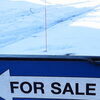Remote control | Banks hope a high-tech way to deposit checks will appeal to current clients and help lure new customers
But that was then. These days, Roshi zaps those checks to her bank with just a few mouse clicks and the help of a high-tech scanner. "We just scan our checks three or four times a day and that's that," says Roshi, whose company last fall signed up for a new service from KeyBank called Key Capture. "It saves us money because it saves us time. Instead of running off to the bank, people can stay at their desks and continue to do work that brings in more money."
So-called "remote capture" technologies like KeyBank's Key Capture are gaining traction among corporate banking customers. Made possible by legislation commonly referred to as "Check 21," which became law in 2004, businesses can now scan checks they receive from their customers and clients and send those digital images to banks instead of depositing physical checks. Just how fast it's catching on is a bit surprising. In an American Bankers Association survey released last month in the ABA Banking Journal, remote capture was ranked first among banks' top technology spending priorities ˆ and this is the first year the technology was included in the survey. In fact, remote capture edged just ahead of Internet banking, which has been a major priority among even the smallest U.S. banks in recent years.
For commercial customers, the upside is clear: Remote capture means no more midday trips to the bank to deposit checks, no more waiting in teller lines and no more missed branch hours. More importantly, as competition continues to heat up in the banking industry, more and more banks are looking for any edge to gain and retain customers. For many, remote capture might be the next step.
Banks that already have rolled out remote capture products are seeing big increases in use. Mercator Advisory Group, a consumer payments industry research firm in Waltham, Mass., noted in a January study that Cincinnati-based regional bank Fifth Third processed $5 billion in check image deposits between November 2005 and September 2006. Among those deposits, a whopping 45% were recorded in August and September of 2006.
In December, Key Bank processed $1.3 billion worth of checks through its nationwide Key Capture system, which now counts more than a thousand customers across the country after launching almost two years ago, according to Laurie Werts, a treasury relationship manager based in Portland. Key started 2006 with around 150 Key Capture customers nationwide. By the beginning of this year, that number grew to more than 1,000. In Maine, the company had just 12 Key Capture customers at the end of last year, but Werts says that number is growing steadily.
Meanwhile, Portland-based TD Banknorth debuted its Digital Express remote capture program last summer and already has signed up roughly 100 customers, says David Jamison, the bank's cash management sales and service representative.
Smaller Maine banks are beginning to look to remote capture, too. Peter Greene, senior vice president and chief administrative officer at Union Trust, an Ellsworth-based bank with 13 branches in the midcoast area, expects the bank to launch its as-yet-unnamed remote capture offering by May. "At Union Trust, we don't like to be on the bleeding edge when it comes to implementing new technology, but we don't want to be last either," says Greene.
"We wanted to make sure we had a sound system in place and a useful service to offer our customers. And after studying this issue since last year, we figured the timing made sense, since this is really beginning to take off."
Scan, sendˆ done
The process of remote capture is relatively simple: The customer scans a check using a specialized scanner either purchased outright ˆ they can be had for less than $1,000 ˆ or leased from the bank as part of the remote capture service. The image is then either transmitted to the bank via software on the customer's computer or through a Web-based portal that the scanner links to directly.
Unless the scan is unclear, the customer doesn't have anything else to worry about, aside from keeping the physical check locked away for a short period of time before destroying it. (In the rare event there is a problem with the scan , the customer is notified and can re-scan the check or, if it still doesn't scan clearly, deposit it physically the next time they go to the bank.)
From the consumer's perspective, remote capture makes good financial sense. Christopher Robbins, president of Evest Lending, a mortgage company in Westbrook, says his company earlier this year signed up for KeyBank's Key Capture service. "It costs me somewhere in the neighborhood of 150 bucks a month," says Robbins, whose company handles checks from multiple sources during every mortgage closing. "But it's largely irrelevant because I can make up that cost at just one of my branches in a week just with the DHL Express delivery fees I don't have to pay now."
Although Evest Lending has several branch offices, Robbins didn't want to go with a full-scale implementation at first, and focused on giving it a trial run just at the corporate main office. Now he's ready to bring remote capture into his branches in Massachusetts.
"Just because it sounds wonderful doesn't mean it will work," he notes. "But we've been running it now for about two months at corporate and it's wonderful. There have been absolutely zero glitches, which surprised me. And our trips to the bank are almost zero now."
The costs vary widely depending on the size of the customer's business, how long they've been with the bank or how many other services they use. Jamison says that TD Banknorth doesn't even offer a pricing sheet on the Digital Express service. But as KeyBank's Werts notes, her bank and others aren't pricing remote capture as a profit maker.
Still, it is something bank execs say will save money. One way it will save is by cutting transportation costs. Greene says that although banks in Maine overall are only just now getting the technology going for customers, he suspects that Maine banks have probably been a bit quicker to adopt remote capture for their own dealings with the Federal Reserve ˆ where banks send customers' checks ˆbecause of Maine's relative isolation compared to many other states.
"The closest Fed check clearing office is in Connecticut, so it made sense for banks here to get on board with the Check 21 image clearing process early," he says. "Our courier costs are just so much greater than for many other states. Along with several other banks, we've been paying for a plane every day to haul our checks to the Fed. So cost savings have been at the top of our list in embracing remote deposit capture."
All in the presentation
The real benefit of remote capture as a service offering is in retaining customers, increasing their business with the bank, and drawing commercial and merchant customers away from the competition. "With Maine being largely rural, offering remote capture is incredibly important, and increasingly so, for retaining and attracting customers," adds George Peabody, director of the Emerging Technologies Advisory Service for Mercator Advisory Group.
The downside for community banks, which have fewer resources than large banks, is that they have to be willing to absorb the costs for remote capture, which often are disproportionately higher for smaller banks. As Greene notes, a large bank can shell out the money to create an in-house system and thus have a fixed cost. That's harder for a bank like Union Trust, which has just a fraction of the total assets of a Bank of America or even TD Banknorth. Still, it doesn't mean Union Trust can ignore remote capture. "We need remote capture," says Greene. "I see it as a requirement of all banks to retain their business and gain new customers and, hopefully, banks like us that roll it out sooner rather than later will have a competitive advantage there."
Union Trust's initial remote capture program is being developed with a vendor on a pay-as-you-go basis, where the bank pays a transaction fee for each remote capture customer, and thus has a variable-cost structure that grows as the customer base grows.
But Union Trust is spending about $50,000 this year for a new server, software and support to handle its entire Check 21 implementation, which includes its own digital check clearance with the Federal Reserve as well as its upcoming remote capture customer service.
The reduction in paper handling and shipping might suggest less need for bank staff, but Werts insists that as remote capture continues to move forward, it really just means shifting of duties and greater efficiencies in staff workloads. Greene agrees, adding that at community banks in particular, which often have little wiggle room in their staffing, it's not a matter of needing less people. Instead, it's a matter of getting existing people up to speed on the more automated ways of doing business.
For George Peabody, there's no reason even the smallest banks aren't embracing remote capture. And in contrast to even just a few years ago, there's plenty of technology options available for banks that want to offer remote capture products, he says. But what's required is a willingness for banks to change direction. "It's a win-win for banks and their customers, so those who don't deploy it soon may live to regret that choice in the long run," he says. "The only people losing out from remote capture are trucking and aviation companies."










Comments